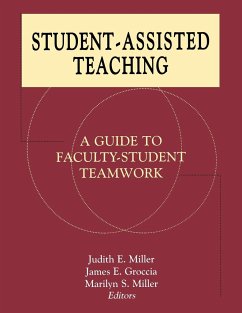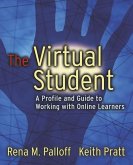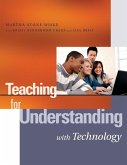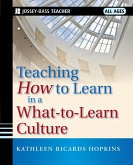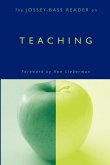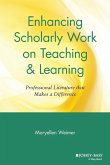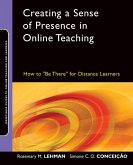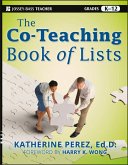Student-Assisted Teaching
A Guide to Faculty-Student Teamwork
Herausgeber: Miller, Judith E; Miller, Marilyn S; Groccia, James E
Student-Assisted Teaching
A Guide to Faculty-Student Teamwork
Herausgeber: Miller, Judith E; Miller, Marilyn S; Groccia, James E
- Broschiertes Buch
- Merkliste
- Auf die Merkliste
- Bewerten Bewerten
- Teilen
- Produkt teilen
- Produkterinnerung
- Produkterinnerung
This innovative book provides a range of models for undergraduate student-assisted teaching partnerships to help faculty, faculty developers, and administrators make learning more student-centered, more effective, and more productive. Each of the 31 models included in this volume is supported with practical details and focuses on four main aspects of a specific peer-assisted learning environment: 1) implementation, 2) evidence of effectiveness and learning benefits, 3) analysis of time and cost expenditures, and 4) suggestions for replication. The chapters present a range of approaches,…mehr
![The Virtual Student The Virtual Student]() Rena M PalloffThe Virtual Student48,99 €
Rena M PalloffThe Virtual Student48,99 €![Teaching for Understanding with Technology Teaching for Understanding with Technology]() Martha Stone WiskeTeaching for Understanding with Technology35,99 €
Martha Stone WiskeTeaching for Understanding with Technology35,99 €![Teaching How to Learn in a What-to-Learn Culture Teaching How to Learn in a What-to-Learn Culture]() Kathleen R HopkinsTeaching How to Learn in a What-to-Learn Culture26,99 €
Kathleen R HopkinsTeaching How to Learn in a What-to-Learn Culture26,99 €![JB Reader on Teaching JB Reader on Teaching]() Jossey-Bass PublishersJB Reader on Teaching47,99 €
Jossey-Bass PublishersJB Reader on Teaching47,99 €![Enhancing Scholarly Work on Teaching and Learning Enhancing Scholarly Work on Teaching and Learning]() Maryellen WeimerEnhancing Scholarly Work on Teaching and Learning44,99 €
Maryellen WeimerEnhancing Scholarly Work on Teaching and Learning44,99 €![Creating a Sense of Presence in Online Teaching Creating a Sense of Presence in Online Teaching]() Rosemary M LehmanCreating a Sense of Presence in Online Teaching38,99 €
Rosemary M LehmanCreating a Sense of Presence in Online Teaching38,99 €![The Co-Teaching Book of Lists The Co-Teaching Book of Lists]() Katherine D PerezThe Co-Teaching Book of Lists28,99 €
Katherine D PerezThe Co-Teaching Book of Lists28,99 €-
-
-
Hinweis: Dieser Artikel kann nur an eine deutsche Lieferadresse ausgeliefert werden.
- Produktdetails
- Verlag: Wiley
- Seitenzahl: 252
- Erscheinungstermin: 1. Januar 2001
- Englisch
- Abmessung: 280mm x 216mm x 14mm
- Gewicht: 644g
- ISBN-13: 9781882982424
- ISBN-10: 1882982428
- Artikelnr.: 22982825
- Verlag: Wiley
- Seitenzahl: 252
- Erscheinungstermin: 1. Januar 2001
- Englisch
- Abmessung: 280mm x 216mm x 14mm
- Gewicht: 644g
- ISBN-13: 9781882982424
- ISBN-10: 1882982428
- Artikelnr.: 22982825
Foreword.
Preface.
Introduction.
Model Matrix.
Part I. Undergraduate Students Assisting with Programs for First-Year
Students.
1. Establishing a Common Ground: A Cojoint Training Model for Instructors
and Peer Educators. (Eve M. Adams, Susan C. Brown, and Terry L. Cook).
2. Lessons From Peers: The Design Exchange Mark J. Chidister, Frank H.
Bell, Jr., and Kurt M. Earnest).
3. Peer Teaching in the Experimental College (Robyn Gittleman and Howard
Woolf).
4. Peer Facilitators as Lead Freshman Seminar Instructors Jean M.
Henscheid).
5. The Teaching Teams Program: A Just-in-Time model for Peer Assistance
Harold P. Larson, Reed Mencke, Stacy J. Tollefson, Elizabeth Harrison, and
Elena Berman).
6. The Teaching Teams Program: Transforming the Role of the Graduate
Teaching Assistant (David A. Wood, Jr., Jennifer L. Hart, Stacy J.
Tollefson, Dawn E. DeToro, and Julie Libarkin).
7. The Teaching Teams Program: Empowering Undergraduates in a
Student-Centered Research University (Lacey A. Stover, Kristen A. Story,
Amanda M. Skousen, Cynthia E. Jacks, Heather Logan, and Benjamin T. Bush).
8. Peer-Assisted Cooperative Learning: An Experiment in Educational Quality
and Productivity (Judith E. Miller, david DiBiasio, John Minasian, and
James S. Catterall).
9. Students: Managing to Learn; Teachers: Learning to Manage (Martin H.
Murray).
10. Undergraduates Teaching in a Collaborative Learning Paradigm (Samuel B.
Thompson, Sarah B. Westfall, and Christine Reimers).
11. Peers at Work: Tutors at Spelman College (Anne B. Warner and Christine
K. Farris).
12. Students Mentoring Students in Portfolio Development (W. Alan Wright
and Bruce Barton).
Part II. Undergraduate Students Assisting with Difficult Courses.
13. The Experimental Study Group: An Alternative First-Year Program at MIT
(David Custer and Peter Dourmashkin).
14. MASH (Math and Science Help): Supplemental Instruction at a
Technological University (Ann garvin and Dale Snyder).
15. Undergraduate Peer Mentors in Mathematics (Miguel Paredes, Paul
Pontius, Rene Torres, and Joseph Chance).
16. A Model for Integrating Technical Preceptors into the Classroom (Mary
Poulton and John Kemeny).
17. Academic Excellence Workshops: Boosting Success in Technical Courses
(Ruth A. Streveler).
18. Supplemental Instruction at an Urban Community College (Joyce Ship
Zaritsky).
Part III. Undergraduate Students Assisting with Special Groups.
19. Peer-Assisted Teaching and Learning in Distance education (Judith A.
Couchman).
20. Using Structured Study Groups to Create Chemistry Honors Sections
(Brian P. Coppola, Douglas S. Daniels, and Jason K. Pontrello).
21. Student Mentoring and Community in a University Honors Program (Ronald
E. Mickel).
22. Where Undergraduates are the Experts: Peer-Based Instruction in the
Writing Center (Dennis Paoli and Eric Hobson).
Part IV. Undergraduate Students Assisting in Courses and Programs for All
Students.
23. Peer Facilitators of In-Class Groups: Adapting Problem-Based Learning
to the Undergraduate Setting (Deborah E. Allen and Harold B. White, III).
24. Student-Directed Instruction in an Undergraduate Psychopathology Course
(Cheryl Golden and Calverta McMorris).
25. Peer Writing Tours (Lisa Lebduska).
26. The Workshop Project: Peer-Led team Learning in Chemistry (Jerry L.
Sarquis. Linda J. Dixon, David K. Gosser, Jack A. Kampmeier, Vicki Roth,
Victor S. Strozak, and Pratibha varma-Nelson).
27. An Introductory Psychology Laboratory designed and Taught by
Undergraduate Teaching Interns (Stephen P. Stelzner, Michael G. Livingston,
and Thomas Creed).
28. Undergraduate Teaching Assistants Bring Active Learning to Class
(Melissa A. Thibodeau).
Part V. Undergraduate Students Assisting in Faculty Development.
29. Student-Faculty Partnerships to develop Teaching and Enhance Learning
(Milton D. Cox).
30. Educating the Critic: Student Driven Quality (Elizabeth Kinland, Lisa
Firing Lenze, Lynn Melander Moore, and Larry D. Spence).
31. College Teachers and Student Consultants: Collaborating about Teaching
and Learning (D. Lynn Sorenson).
Foreword.
Preface.
Introduction.
Model Matrix.
Part I. Undergraduate Students Assisting with Programs for First-Year
Students.
1. Establishing a Common Ground: A Cojoint Training Model for Instructors
and Peer Educators. (Eve M. Adams, Susan C. Brown, and Terry L. Cook).
2. Lessons From Peers: The Design Exchange Mark J. Chidister, Frank H.
Bell, Jr., and Kurt M. Earnest).
3. Peer Teaching in the Experimental College (Robyn Gittleman and Howard
Woolf).
4. Peer Facilitators as Lead Freshman Seminar Instructors Jean M.
Henscheid).
5. The Teaching Teams Program: A Just-in-Time model for Peer Assistance
Harold P. Larson, Reed Mencke, Stacy J. Tollefson, Elizabeth Harrison, and
Elena Berman).
6. The Teaching Teams Program: Transforming the Role of the Graduate
Teaching Assistant (David A. Wood, Jr., Jennifer L. Hart, Stacy J.
Tollefson, Dawn E. DeToro, and Julie Libarkin).
7. The Teaching Teams Program: Empowering Undergraduates in a
Student-Centered Research University (Lacey A. Stover, Kristen A. Story,
Amanda M. Skousen, Cynthia E. Jacks, Heather Logan, and Benjamin T. Bush).
8. Peer-Assisted Cooperative Learning: An Experiment in Educational Quality
and Productivity (Judith E. Miller, david DiBiasio, John Minasian, and
James S. Catterall).
9. Students: Managing to Learn; Teachers: Learning to Manage (Martin H.
Murray).
10. Undergraduates Teaching in a Collaborative Learning Paradigm (Samuel B.
Thompson, Sarah B. Westfall, and Christine Reimers).
11. Peers at Work: Tutors at Spelman College (Anne B. Warner and Christine
K. Farris).
12. Students Mentoring Students in Portfolio Development (W. Alan Wright
and Bruce Barton).
Part II. Undergraduate Students Assisting with Difficult Courses.
13. The Experimental Study Group: An Alternative First-Year Program at MIT
(David Custer and Peter Dourmashkin).
14. MASH (Math and Science Help): Supplemental Instruction at a
Technological University (Ann garvin and Dale Snyder).
15. Undergraduate Peer Mentors in Mathematics (Miguel Paredes, Paul
Pontius, Rene Torres, and Joseph Chance).
16. A Model for Integrating Technical Preceptors into the Classroom (Mary
Poulton and John Kemeny).
17. Academic Excellence Workshops: Boosting Success in Technical Courses
(Ruth A. Streveler).
18. Supplemental Instruction at an Urban Community College (Joyce Ship
Zaritsky).
Part III. Undergraduate Students Assisting with Special Groups.
19. Peer-Assisted Teaching and Learning in Distance education (Judith A.
Couchman).
20. Using Structured Study Groups to Create Chemistry Honors Sections
(Brian P. Coppola, Douglas S. Daniels, and Jason K. Pontrello).
21. Student Mentoring and Community in a University Honors Program (Ronald
E. Mickel).
22. Where Undergraduates are the Experts: Peer-Based Instruction in the
Writing Center (Dennis Paoli and Eric Hobson).
Part IV. Undergraduate Students Assisting in Courses and Programs for All
Students.
23. Peer Facilitators of In-Class Groups: Adapting Problem-Based Learning
to the Undergraduate Setting (Deborah E. Allen and Harold B. White, III).
24. Student-Directed Instruction in an Undergraduate Psychopathology Course
(Cheryl Golden and Calverta McMorris).
25. Peer Writing Tours (Lisa Lebduska).
26. The Workshop Project: Peer-Led team Learning in Chemistry (Jerry L.
Sarquis. Linda J. Dixon, David K. Gosser, Jack A. Kampmeier, Vicki Roth,
Victor S. Strozak, and Pratibha varma-Nelson).
27. An Introductory Psychology Laboratory designed and Taught by
Undergraduate Teaching Interns (Stephen P. Stelzner, Michael G. Livingston,
and Thomas Creed).
28. Undergraduate Teaching Assistants Bring Active Learning to Class
(Melissa A. Thibodeau).
Part V. Undergraduate Students Assisting in Faculty Development.
29. Student-Faculty Partnerships to develop Teaching and Enhance Learning
(Milton D. Cox).
30. Educating the Critic: Student Driven Quality (Elizabeth Kinland, Lisa
Firing Lenze, Lynn Melander Moore, and Larry D. Spence).
31. College Teachers and Student Consultants: Collaborating about Teaching
and Learning (D. Lynn Sorenson).
